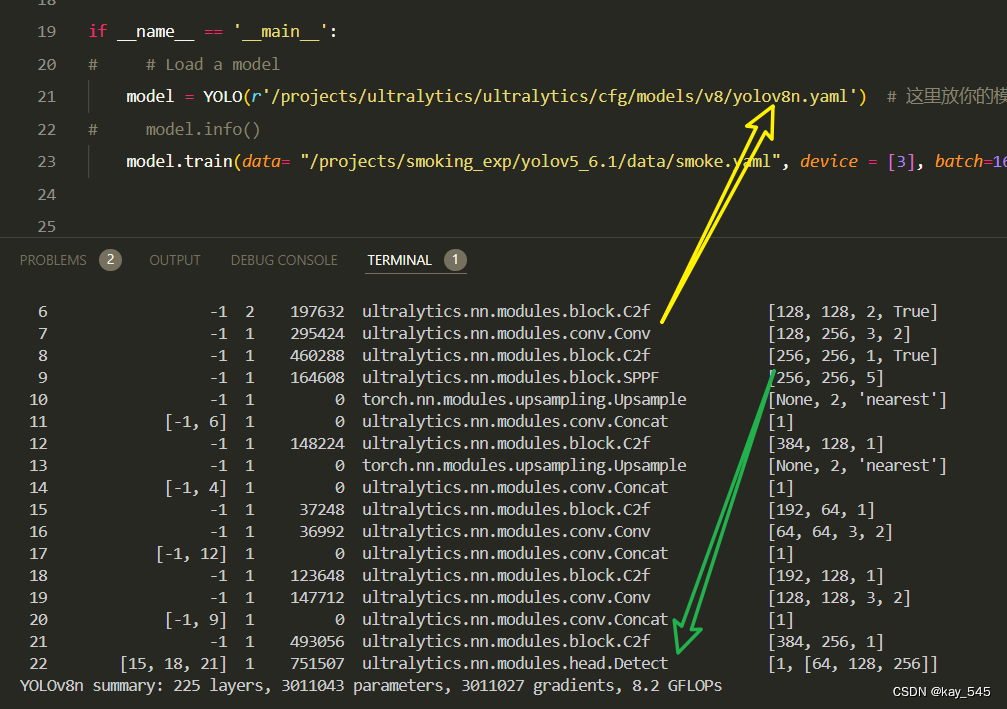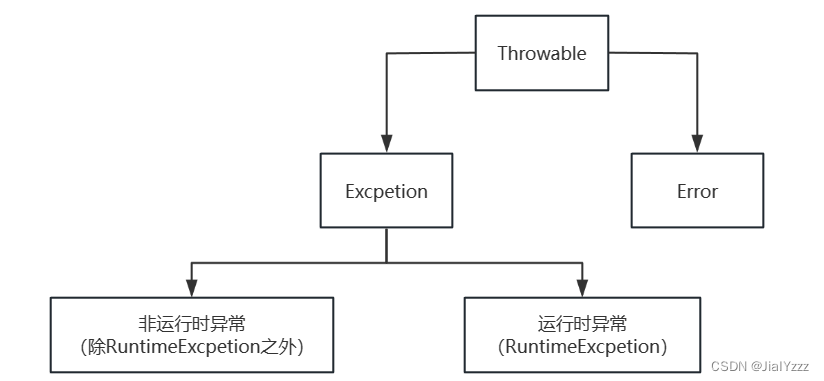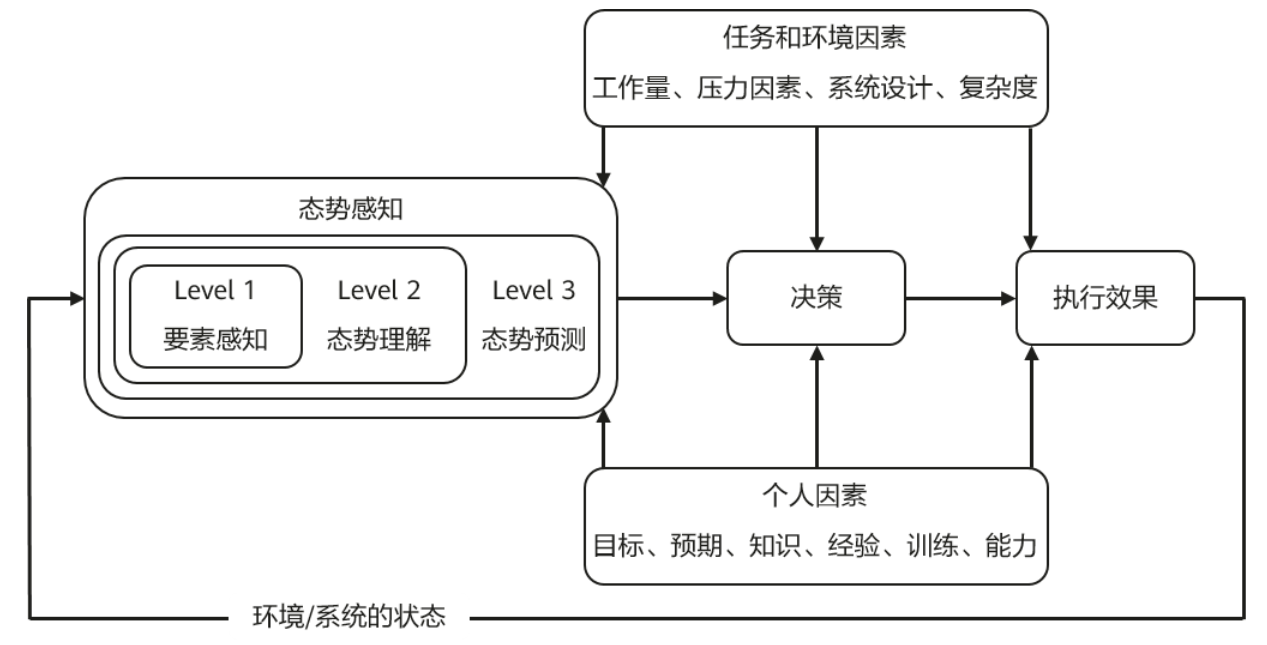秋招面试专栏推荐 :深度学习算法工程师面试问题总结【百面算法工程师】——点击即可跳转
💡💡💡本专栏所有程序均经过测试,可成功执行💡💡💡
专栏目录 :《YOLOv8改进有效涨点》专栏介绍 & 专栏目录 | 目前已有70+篇内容,内含各种Head检测头、损失函数Loss、Backbone、Neck、NMS等创新点改进——点击即可跳转
最近的研究关注到了在网络设计中尚未充分挖掘的“星运算”(逐元素乘法)的潜力。尽管直观的解释有很多,但其应用的基础原理仍然在很大程度上未被探索。我们的研究试图揭示星运算的能力,它能够在不扩大网络的情况下,将输入映射到高维、非线性的特征空间中,类似于核技巧。我们进一步引入了StarNet,这是一个简单但强大的原型,它在紧凑的网络结构和高效的预算下展现了令人印象深刻的性能和低延迟。就像天空中的星星一样,星运算看似不起眼,却蕴含着广阔的潜力宇宙。文章在介绍主要的原理后,将手把手教学如何进行模块的代码添加和修改,并将修改后的完整代码放在文章的最后,方便大家一键运行,小白也可轻松上手实践。以帮助您更好地学习深度学习目标检测YOLO系列的挑战。
专栏地址:YOLOv8改进——更新各种有效涨点方法——点击即可跳转
目录
1.原理
2. 将starNet添加到yolov8网络中
2.1 starNet代码实现
2.2 更改init.py文件
2.3 添加yaml文件
2.4 注册模块
2.5 替换函数
2.6 执行程序
3. 完整代码分享
4. GFLOPs
5. 进阶
6. 总结
1.原理

论文地址:Rewrite the Stars⭐ ——点击即可跳转
官方代码:官方代码仓库——点击即可跳转
StarNet的主要原理可以总结如下:
StarNet的核心思想
-
星操作(Star Operation):
-
星操作是指元素级乘法(element-wise multiplication),用于融合不同子空间的特征。
-
这种操作能够将输入特征映射到高维非线性特征空间,类似于核技巧(kernel tricks),而不需要增加网络的宽度(通道数)。
-
-
高维非线性特征映射:
-
星操作通过元素级乘法生成一个新的特征空间,这个特征空间具有大约((d\sqrt{2})^2)个线性独立的维度。
-
这种操作与传统神经网络通过增加网络宽度来获得高维特征的方式不同,更像是多项式核函数(polynomial kernel functions)的操作。
-
-
高效的紧凑网络结构:
-
通过堆叠多个星操作层,每一层都显著增加隐含的维度复杂度。
-
即使在紧凑的特征空间中操作,星操作仍然能够利用隐含的高维特征。
-
-
性能和效率:
-
星操作在性能和效率上表现出色,尤其是在网络宽度较小的情况下。
-
StarNet使用星操作设计了一个简单但高效的网络结构,证明了其在紧凑网络中的有效性。
-
StarNet的实现
-
网络结构:
-
StarNet通过堆叠多层星操作层构建
-

2. 星操作层的基本形式为,即通过元素级乘法融合两个线性变换后的特征。
-
理论分析和实验验证:
-
通过理论分析证明了星操作能够在一个层内将输入特征映射到一个高维非线性特征空间,并且在多层堆叠下能够递归地显著增加隐含的特征维度。
-
实验结果表明,StarNet在ImageNet-1K验证集上的表现优于许多精心设计的高效模型,并且在实际应用中具有较低的延迟和较高的运行效率。
-
-
比较与优势:
-
与现有的高效网络设计相比,StarNet没有复杂的设计和超参数调优,仅依赖于星操作的高效性。
-
StarNet的设计理念与传统方法(如卷积、线性层和非线性激活的结合)有明显的不同,强调利用隐含的高维特征来提升网络效率。
-
综上所述,StarNet通过星操作实现了在紧凑网络中的高效性和高性能,展示了元素级乘法在特征融合中的巨大潜力和应用前景。
2. 将starNet添加到yolov8网络中
2.1 starNet代码实现
关键步骤一: 在/ultralytics/ultralytics/nn/modules下新建backbone/starNet.py,并将下面代码粘贴到文件内
"""
Implementation of Prof-of-Concept Network: StarNet.
We make StarNet as simple as possible [to show the key contribution of element-wise multiplication]:
- like NO layer-scale in network design,
- and NO EMA during training,
- which would improve the performance further.
Created by: Xu Ma (Email: ma.xu1@northeastern.edu)
Modified Date: Mar/29/2024
"""
import torch
import torch.nn as nn
from timm.models.layers import DropPath, trunc_normal_
__all__ = [
"starnet_s050",
"starnet_s100",
"starnet_s150",
"starnet_s1",
"starnet_s2",
"starnet_s3",
"starnet_s4",
]
model_urls = {
"starnet_s1": "https://github.com/ma-xu/Rewrite-the-Stars/releases/download/checkpoints_v1/starnet_s1.pth.tar",
"starnet_s2": "https://github.com/ma-xu/Rewrite-the-Stars/releases/download/checkpoints_v1/starnet_s2.pth.tar",
"starnet_s3": "https://github.com/ma-xu/Rewrite-the-Stars/releases/download/checkpoints_v1/starnet_s3.pth.tar",
"starnet_s4": "https://github.com/ma-xu/Rewrite-the-Stars/releases/download/checkpoints_v1/starnet_s4.pth.tar",
}
class ConvBN(torch.nn.Sequential):
def __init__(
self,
in_planes,
out_planes,
kernel_size=1,
stride=1,
padding=0,
dilation=1,
groups=1,
with_bn=True,
):
super().__init__()
self.add_module(
"conv",
torch.nn.Conv2d(
in_planes, out_planes, kernel_size, stride, padding, dilation, groups
),
)
if with_bn:
self.add_module("bn", torch.nn.BatchNorm2d(out_planes))
torch.nn.init.constant_(self.bn.weight, 1)
torch.nn.init.constant_(self.bn.bias, 0)
class Block(nn.Module):
def __init__(self, dim, mlp_ratio=3, drop_path=0.0):
super().__init__()
self.dwconv = ConvBN(dim, dim, 7, 1, (7 - 1) // 2, groups=dim, with_bn=True)
self.f1 = ConvBN(dim, mlp_ratio * dim, 1, with_bn=False)
self.f2 = ConvBN(dim, mlp_ratio * dim, 1, with_bn=False)
self.g = ConvBN(mlp_ratio * dim, dim, 1, with_bn=True)
self.dwconv2 = ConvBN(dim, dim, 7, 1, (7 - 1) // 2, groups=dim, with_bn=False)
self.act = nn.ReLU6()
self.drop_path = DropPath(drop_path) if drop_path > 0.0 else nn.Identity()
def forward(self, x):
input = x
x = self.dwconv(x)
x1, x2 = self.f1(x), self.f2(x)
x = self.act(x1) * x2
x = self.dwconv2(self.g(x))
x = input + self.drop_path(x)
return x
class StarNet(nn.Module):
def __init__(
self,
base_dim=32,
depths=[3, 3, 12, 5],
mlp_ratio=4,
drop_path_rate=0.0,
num_classes=1000,
**kwargs
):
super().__init__()
self.num_classes = num_classes
self.in_channel = 32
# stem layer
self.stem = nn.Sequential(
ConvBN(3, self.in_channel, kernel_size=3, stride=2, padding=1), nn.ReLU6()
)
dpr = [
x.item() for x in torch.linspace(0, drop_path_rate, sum(depths))
] # stochastic depth
# build stages
self.stages = nn.ModuleList()
cur = 0
for i_layer in range(len(depths)):
embed_dim = base_dim * 2**i_layer
down_sampler = ConvBN(self.in_channel, embed_dim, 3, 2, 1)
self.in_channel = embed_dim
blocks = [
Block(self.in_channel, mlp_ratio, dpr[cur + i])
for i in range(depths[i_layer])
]
cur += depths[i_layer]
self.stages.append(nn.Sequential(down_sampler, *blocks))
self.channel = [i.size(1) for i in self.forward(torch.randn(1, 3, 640, 640))]
self.apply(self._init_weights)
def _init_weights(self, m):
if isinstance(m, nn.Linear or nn.Conv2d):
trunc_normal_(m.weight, std=0.02)
if isinstance(m, nn.Linear) and m.bias is not None:
nn.init.constant_(m.bias, 0)
elif isinstance(m, nn.LayerNorm or nn.BatchNorm2d):
nn.init.constant_(m.bias, 0)
nn.init.constant_(m.weight, 1.0)
def forward(self, x):
features = []
x = self.stem(x)
features.append(x)
for stage in self.stages:
x = stage(x)
features.append(x)
return features
def starnet_s1(pretrained=False, **kwargs):
model = StarNet(24, [2, 2, 8, 3], **kwargs)
if pretrained:
url = model_urls["starnet_s1"]
checkpoint = torch.hub.load_state_dict_from_url(url=url, map_location="cpu")
model.load_state_dict(checkpoint["state_dict"], strict=False)
return model
def starnet_s2(pretrained=False, **kwargs):
model = StarNet(32, [1, 2, 6, 2], **kwargs)
if pretrained:
url = model_urls["starnet_s2"]
checkpoint = torch.hub.load_state_dict_from_url(url=url, map_location="cpu")
model.load_state_dict(checkpoint["state_dict"], strict=False)
return model
def starnet_s3(pretrained=False, **kwargs):
model = StarNet(32, [2, 2, 8, 4], **kwargs)
if pretrained:
url = model_urls["starnet_s3"]
checkpoint = torch.hub.load_state_dict_from_url(url=url, map_location="cpu")
model.load_state_dict(checkpoint["state_dict"], strict=False)
return model
def starnet_s4(pretrained=False, **kwargs):
model = StarNet(32, [3, 3, 12, 5], **kwargs)
if pretrained:
url = model_urls["starnet_s4"]
checkpoint = torch.hub.load_state_dict_from_url(url=url, map_location="cpu")
model.load_state_dict(checkpoint["state_dict"], strict=False)
return model
# very small networks #
def starnet_s050(pretrained=False, **kwargs):
return StarNet(16, [1, 1, 3, 1], 3, **kwargs)
def starnet_s100(pretrained=False, **kwargs):
return StarNet(20, [1, 2, 4, 1], 4, **kwargs)
def starnet_s150(pretrained=False, **kwargs):
return StarNet(24, [1, 2, 4, 2], 3, **kwargs)StarNet 处理图像的主要工作流程可以分为几个关键步骤,重点关注独特的星型运算及其在分层网络结构中的集成。以下是主要流程的概述:
1. 分层架构:
-
StarNet 采用 4 阶段分层架构。每个阶段使用卷积层来降低分辨率,同时将通道数加倍。这种分层方法在现代神经网络设计中很常见,有助于逐步抽象多个级别的图像特征。
2. 星型运算:
-
StarNet 的核心创新是星型运算,它在低维空间中计算但产生高维特征。此操作包括使用两组权重转换输入、执行元素乘法以及有选择地应用激活函数。
-
具体来说,星型操作通常实现为
,其中
和
是权重矩阵,act 是应用于转换分支之一的激活函数。
3. 块设计和激活放置:
-
StarNet 中的每个块都使用深度卷积、批量归一化和简化的激活函数 (ReLU6) 来提高效率。这些块设计简约,避免使用复杂的结构,以强调星型操作的有效性。
-
激活的位置经过战略性放置,以平衡计算效率和模型性能。文档中的研究表明,与其他位置相比,仅激活一个分支可获得更好的准确性。
4. 通道扩展和网络宽度:
-
在整个网络中,通道扩展始终设置为 4 倍,网络宽度在每个阶段加倍。这种策略有助于管理计算负载,同时提高网络学习复杂特征的能力。
5. 训练和实施细节:
-
StarNet 采用类似于 DeiT(数据高效图像变换器)的标准训练方案,以确保公平比较和高效训练。
-
在推理过程中,批量规范化层融合以简化网络并减少延迟。
通过利用这些技术,StarNet 设法在简单性、计算效率和高性能之间取得平衡,使其成为图像处理任务的引人注目的方法。

2.2 更改init.py文件
关键步骤二:修改modules文件夹下的__init__.py文件,先导入函数

然后在下面的__all__中声明函数

2.3 添加yaml文件
关键步骤三:在/ultralytics/ultralytics/cfg/models/v8下面新建文件yolov8_starNet.yaml文件,粘贴下面的内容
- OD【目标检测】
# Ultralytics YOLO 🚀, AGPL-3.0 license
# YOLOv8 object detection model with P3-P5 outputs. For Usage examples see https://docs.ultralytics.com/tasks/detect
# Parameters
nc: 80 # number of classes
scales: # model compound scaling constants, i.e. 'model=yolov8n.yaml' will call yolov8.yaml with scale 'n'
# [depth, width, max_channels]
n: [0.33, 0.25, 1024] # YOLOv8n summary: 225 layers, 3157200 parameters, 3157184 gradients, 8.9 GFLOPs
s: [0.33, 0.50, 1024] # YOLOv8s summary: 225 layers, 11166560 parameters, 11166544 gradients, 28.8 GFLOPs
m: [0.67, 0.75, 768] # YOLOv8m summary: 295 layers, 25902640 parameters, 25902624 gradients, 79.3 GFLOPs
l: [1.00, 1.00, 512] # YOLOv8l summary: 365 layers, 43691520 parameters, 43691504 gradients, 165.7 GFLOPs
x: [1.00, 1.25, 512] # YOLOv8x summary: 365 layers, 68229648 parameters, 68229632 gradients, 258.5 GFLOPs
# 0-P1/2
# 1-P2/4
# 2-P3/8
# 3-P4/16
# 4-P5/32
# YOLOv8.0n backbone
backbone:
# [from, repeats, module, args]
- [-1, 1, starnet_s050, []] # 4
- [-1, 1, SPPF, [1024, 5]] # 5
# YOLOv8.0n head
head:
- [-1, 1, nn.Upsample, [None, 2, 'nearest']] # 6
- [[-1, 3], 1, Concat, [1]] # 7 cat backbone P4
- [-1, 3, C2f, [512]] # 8
- [-1, 1, nn.Upsample, [None, 2, 'nearest']] # 9
- [[-1, 2], 1, Concat, [1]] # 10 cat backbone P3
- [-1, 3, C2f, [256]] # 11 (P3/8-small)
- [-1, 1, Conv, [256, 3, 2]] # 12
- [[-1, 8], 1, Concat, [1]] # 13 cat head P4
- [-1, 3, C2f, [512]] # 14 (P4/16-medium)
- [-1, 1, Conv, [512, 3, 2]] # 15
- [[-1, 5], 1, Concat, [1]] # 16 cat head P5
- [-1, 3, C2f, [1024]] # 17 (P5/32-large)
- [[11, 14, 17], 1, Detect, [nc]] # Detect(P3, P4, P5)
- Seg【语义分割】
# Ultralytics YOLO 🚀, AGPL-3.0 license
# YOLOv8 object detection model with P3-P5 outputs. For Usage examples see https://docs.ultralytics.com/tasks/detect
# Parameters
nc: 80 # number of classes
scales: # model compound scaling constants, i.e. 'model=yolov8n.yaml' will call yolov8.yaml with scale 'n'
# [depth, width, max_channels]
n: [0.33, 0.25, 1024] # YOLOv8n summary: 225 layers, 3157200 parameters, 3157184 gradients, 8.9 GFLOPs
s: [0.33, 0.50, 1024] # YOLOv8s summary: 225 layers, 11166560 parameters, 11166544 gradients, 28.8 GFLOPs
m: [0.67, 0.75, 768] # YOLOv8m summary: 295 layers, 25902640 parameters, 25902624 gradients, 79.3 GFLOPs
l: [1.00, 1.00, 512] # YOLOv8l summary: 365 layers, 43691520 parameters, 43691504 gradients, 165.7 GFLOPs
x: [1.00, 1.25, 512] # YOLOv8x summary: 365 layers, 68229648 parameters, 68229632 gradients, 258.5 GFLOPs
# 0-P1/2
# 1-P2/4
# 2-P3/8
# 3-P4/16
# 4-P5/32
# YOLOv8.0n backbone
backbone:
# [from, repeats, module, args]
- [-1, 1, starnet_s050, []] # 4
- [-1, 1, SPPF, [1024, 5]] # 5
# YOLOv8.0n head
head:
- [-1, 1, nn.Upsample, [None, 2, 'nearest']] # 6
- [[-1, 3], 1, Concat, [1]] # 7 cat backbone P4
- [-1, 3, C2f, [512]] # 8
- [-1, 1, nn.Upsample, [None, 2, 'nearest']] # 9
- [[-1, 2], 1, Concat, [1]] # 10 cat backbone P3
- [-1, 3, C2f, [256]] # 11 (P3/8-small)
- [-1, 1, Conv, [256, 3, 2]] # 12
- [[-1, 8], 1, Concat, [1]] # 13 cat head P4
- [-1, 3, C2f, [512]] # 14 (P4/16-medium)
- [-1, 1, Conv, [512, 3, 2]] # 15
- [[-1, 5], 1, Concat, [1]] # 16 cat head P5
- [-1, 3, C2f, [1024]] # 17 (P5/32-large)
- [[11, 14, 17], 1, Segment, [nc, 32, 256]] # Detect(P3, P4, P5)
- OBB【旋转检测】
# Ultralytics YOLO 🚀, AGPL-3.0 license
# YOLOv8 object detection model with P3-P5 outputs. For Usage examples see https://docs.ultralytics.com/tasks/detect
# Parameters
nc: 80 # number of classes
scales: # model compound scaling constants, i.e. 'model=yolov8n.yaml' will call yolov8.yaml with scale 'n'
# [depth, width, max_channels]
n: [0.33, 0.25, 1024] # YOLOv8n summary: 225 layers, 3157200 parameters, 3157184 gradients, 8.9 GFLOPs
s: [0.33, 0.50, 1024] # YOLOv8s summary: 225 layers, 11166560 parameters, 11166544 gradients, 28.8 GFLOPs
m: [0.67, 0.75, 768] # YOLOv8m summary: 295 layers, 25902640 parameters, 25902624 gradients, 79.3 GFLOPs
l: [1.00, 1.00, 512] # YOLOv8l summary: 365 layers, 43691520 parameters, 43691504 gradients, 165.7 GFLOPs
x: [1.00, 1.25, 512] # YOLOv8x summary: 365 layers, 68229648 parameters, 68229632 gradients, 258.5 GFLOPs
# 0-P1/2
# 1-P2/4
# 2-P3/8
# 3-P4/16
# 4-P5/32
# YOLOv8.0n backbone
backbone:
# [from, repeats, module, args]
- [-1, 1, starnet_s050, []] # 4
- [-1, 1, SPPF, [1024, 5]] # 5
# YOLOv8.0n head
head:
- [-1, 1, nn.Upsample, [None, 2, 'nearest']] # 6
- [[-1, 3], 1, Concat, [1]] # 7 cat backbone P4
- [-1, 3, C2f, [512]] # 8
- [-1, 1, nn.Upsample, [None, 2, 'nearest']] # 9
- [[-1, 2], 1, Concat, [1]] # 10 cat backbone P3
- [-1, 3, C2f, [256]] # 11 (P3/8-small)
- [-1, 1, Conv, [256, 3, 2]] # 12
- [[-1, 8], 1, Concat, [1]] # 13 cat head P4
- [-1, 3, C2f, [512]] # 14 (P4/16-medium)
- [-1, 1, Conv, [512, 3, 2]] # 15
- [[-1, 5], 1, Concat, [1]] # 16 cat head P5
- [-1, 3, C2f, [1024]] # 17 (P5/32-large)
- [[11, 14, 17], 1, OBB, [nc, 1]] # Detect(P3, P4, P5)
温馨提示:因为本文只是对yolov8基础上添加模块,如果要对yolov8n/l/m/x进行添加则只需要指定对应的depth_multiple 和 width_multiple。
# YOLOv8n
depth_multiple: 0.33 # model depth multiple
width_multiple: 0.25 # layer channel multiple
max_channels: 1024 # max_channels
# YOLOv8s
depth_multiple: 0.33 # model depth multiple
width_multiple: 0.50 # layer channel multiple
max_channels: 1024 # max_channels
# YOLOv8l
depth_multiple: 1.0 # model depth multiple
width_multiple: 1.0 # layer channel multiple
max_channels: 512 # max_channels
# YOLOv8m
depth_multiple: 0.67 # model depth multiple
width_multiple: 0.75 # layer channel multiple
max_channels: 768 # max_channels
# YOLOv8x
depth_multiple: 1.33 # model depth multiple
width_multiple: 1.25 # layer channel multiple
max_channels: 512 # max_channels2.4 注册模块
关键步骤四:在task.py的parse_model函数替换为下面的内容
def parse_model(
d, ch, verbose=True, warehouse_manager=None
): # model_dict, input_channels(3)
"""Parse a YOLO model.yaml dictionary into a PyTorch model."""
import ast
# Args
max_channels = float("inf")
nc, act, scales = (d.get(x) for x in ("nc", "activation", "scales"))
depth, width, kpt_shape = (
d.get(x, 1.0) for x in ("depth_multiple", "width_multiple", "kpt_shape")
)
if scales:
scale = d.get("scale")
if not scale:
scale = tuple(scales.keys())[0]
LOGGER.warning(
f"WARNING ⚠️ no model scale passed. Assuming scale='{scale}'."
)
depth, width, max_channels = scales[scale]
if act:
Conv.default_act = eval(
act
) # redefine default activation, i.e. Conv.default_act = nn.SiLU()
if verbose:
LOGGER.info(f"{colorstr('activation:')} {act}") # print
if verbose:
LOGGER.info(
f"\n{'':>3}{'from':>20}{'n':>3}{'params':>10} {'module':<45}{'arguments':<30}"
)
ch = [ch]
layers, save, c2 = [], [], ch[-1] # layers, savelist, ch out
is_backbone = False
for i, (f, n, m, args) in enumerate(
d["backbone"] + d["head"]
): # from, number, module, args
try:
if m == "node_mode":
m = d[m]
if len(args) > 0:
if args[0] == "head_channel":
args[0] = int(d[args[0]])
t = m
m = getattr(torch.nn, m[3:]) if "nn." in m else globals()[m] # get module
except:
pass
for j, a in enumerate(args):
if isinstance(a, str):
with contextlib.suppress(ValueError):
try:
args[j] = locals()[a] if a in locals() else ast.literal_eval(a)
except:
args[j] = a
n = n_ = max(round(n * depth), 1) if n > 1 else n # depth gain
if m in (
Classify,
Conv,
ConvTranspose,
GhostConv,
Bottleneck,
GhostBottleneck,
SPP,
SPPF,
DWConv,
Focus,
BottleneckCSP,
C1,
C2,
C2f,
C3,
C3TR,
C3Ghost,
nn.Conv2d,
nn.ConvTranspose2d,
DWConvTranspose2d,
C3x,
RepC3,
):
if args[0] == "head_channel":
args[0] = d[args[0]]
c1, c2 = ch[f], args[0]
if (
c2 != nc
): # if c2 not equal to number of classes (i.e. for Classify() output)
c2 = make_divisible(min(c2, max_channels) * width, 8)
args = [c1, c2, *args[1:]]
if m in (
RepNCSPELAN4,
):
args[2] = make_divisible(min(args[2], max_channels) * width, 8)
args[3] = make_divisible(min(args[3], max_channels) * width, 8)
if m in (
BottleneckCSP,
C1,
C2,
C2f,
C3,
C3TR,
C3Ghost,
C3x,
RepC3,
):
args.insert(2, n) # number of repeats
n = 1
elif m is AIFI:
args = [ch[f], *args]
elif m in (HGStem, HGBlock):
c1, cm, c2 = ch[f], args[0], args[1]
if (
c2 != nc
): # if c2 not equal to number of classes (i.e. for Classify() output)
c2 = make_divisible(min(c2, max_channels) * width, 8)
cm = make_divisible(min(cm, max_channels) * width, 8)
args = [c1, cm, c2, *args[2:]]
if m in (HGBlock):
args.insert(4, n) # number of repeats
n = 1
elif m is ResNetLayer:
c2 = args[1] if args[3] else args[1] * 4
elif m is nn.BatchNorm2d:
args = [ch[f]]
elif m is Concat:
c2 = sum(ch[x] for x in f)
elif m in (
Detect,
Segment,
Pose,
OBB,
):
args.append([ch[x] for x in f])
if m in (
Segment,
):
args[2] = make_divisible(min(args[2], max_channels) * width, 8)
elif m is RTDETRDecoder: # special case, channels arg must be passed in index 1
args.insert(1, [ch[x] for x in f])
elif m is CBLinear:
c2 = make_divisible(min(args[0][-1], max_channels) * width, 8)
c1 = ch[f]
args = [
c1,
[make_divisible(min(c2_, max_channels) * width, 8) for c2_ in args[0]],
*args[1:],
]
elif m is CBFuse:
c2 = ch[f[-1]]
elif isinstance(m, str):
t = m
if len(args) == 2:
m = timm.create_model(
m,
pretrained=args[0],
pretrained_cfg_overlay={"file": args[1]},
features_only=True,
)
elif len(args) == 1:
m = timm.create_model(m, pretrained=args[0], features_only=True)
c2 = m.feature_info.channels()
elif m in {
starnet_s050,
starnet_s100,
starnet_s150,
starnet_s1,
starnet_s2,
starnet_s3,
starnet_s4,
}:
m = m(*args)
c2 = m.channel
else:
c2 = ch[f]
if isinstance(c2, list):
is_backbone = True
m_ = m
m_.backbone = True
else:
m_ = (
nn.Sequential(*(m(*args) for _ in range(n))) if n > 1 else m(*args)
) # module
t = str(m)[8:-2].replace("__main__.", "") # module type
m.np = sum(x.numel() for x in m_.parameters()) # number params
m_.i, m_.f, m_.type = (
i + 4 if is_backbone else i,
f,
t,
) # attach index, 'from' index, type
if verbose:
LOGGER.info(
f"{i:>3}{str(f):>20}{n_:>3}{m.np:10.0f} {t:<45}{str(args):<30}"
) # print
save.extend(
x % (i + 4 if is_backbone else i)
for x in ([f] if isinstance(f, int) else f)
if x != -1
) # append to savelist
layers.append(m_)
if i == 0:
ch = []
if isinstance(c2, list):
ch.extend(c2)
for _ in range(5 - len(ch)):
ch.insert(0, 0)
else:
ch.append(c2)
return nn.Sequential(*layers), sorted(save)2.5 替换函数
关键步骤五:在task.py的BaseModel类下的_predict_once函数替换为下面的内容
def _predict_once(self, x, profile=False, visualize=False, embed=None):
"""
Perform a forward pass through the network.
Args:
x (torch.Tensor): The input tensor to the model.
profile (bool): Print the computation time of each layer if True, defaults to False.
visualize (bool): Save the feature maps of the model if True, defaults to False.
embed (list, optional): A list of feature vectors/embeddings to return.
Returns:
(torch.Tensor): The last output of the model.
"""
y, dt, embeddings = [], [], [] # outputs
for m in self.model:
if m.f != -1: # if not from previous layer
x = (
y[m.f]
if isinstance(m.f, int)
else [x if j == -1 else y[j] for j in m.f]
) # from earlier layers
if profile:
self._profile_one_layer(m, x, dt)
if hasattr(m, "backbone"):
x = m(x)
for _ in range(5 - len(x)):
x.insert(0, None)
for i_idx, i in enumerate(x):
if i_idx in self.save:
y.append(i)
else:
y.append(None)
# for i in x:
# if i is not None:
# print(i.size())
x = x[-1]
else:
x = m(x) # run
y.append(x if m.i in self.save else None) # save output
if visualize:
feature_visualization(x, m.type, m.i, save_dir=visualize)
if embed and m.i in embed:
embeddings.append(
nn.functional.adaptive_avg_pool2d(x, (1, 1)).squeeze(-1).squeeze(-1)
) # flatten
if m.i == max(embed):
return torch.unbind(torch.cat(embeddings, 1), dim=0)
return x2.6 执行程序
在train.py中,将model的参数路径设置为yolov8_starNet.yaml的路径
建议大家写绝对路径,确保一定能找到
from ultralytics import YOLO
# Load a model
# model = YOLO('yolov8n.yaml') # build a new model from YAML
# model = YOLO('yolov8n.pt') # load a pretrained model (recommended for training)
model = YOLO(r'/projects/ultralytics/ultralytics/cfg/models/v8/yolov8_starNet.yaml') # build from YAML and transfer weights
# Train the model
model.train(batch=16)🚀运行程序,如果出现下面的内容则说明添加成功🚀
from n params module arguments
0 -1 1 413472 starnet_s050 []
1 -1 1 74368 ultralytics.nn.modules.block.SPPF [128, 256, 5]
2 -1 1 0 torch.nn.modules.upsampling.Upsample [None, 2, 'nearest']
3 [-1, 3] 1 0 ultralytics.nn.modules.conv.Concat [1]
4 -1 1 140032 ultralytics.nn.modules.block.C2f [320, 128, 1]
5 -1 1 0 torch.nn.modules.upsampling.Upsample [None, 2, 'nearest']
6 [-1, 2] 1 0 ultralytics.nn.modules.conv.Concat [1]
7 -1 1 35200 ultralytics.nn.modules.block.C2f [160, 64, 1]
8 -1 1 36992 ultralytics.nn.modules.conv.Conv [64, 64, 3, 2]
9 [-1, 8] 1 0 ultralytics.nn.modules.conv.Concat [1]
10 -1 1 123648 ultralytics.nn.modules.block.C2f [192, 128, 1]
11 -1 1 147712 ultralytics.nn.modules.conv.Conv [128, 128, 3, 2]
12 [-1, 5] 1 0 ultralytics.nn.modules.conv.Concat [1]
13 -1 1 493056 ultralytics.nn.modules.block.C2f [384, 256, 1]
14 [11, 14, 17] 1 897664 ultralytics.nn.modules.head.Detect [80, [64, 128, 256]]
YOLOv8_starnet summary: 249 layers, 2362144 parameters, 2362128 gradients 7.2 GFLOPs3. 完整代码分享
https://pan.baidu.com/s/1Xn-L1oK3c5jFgyCNwNMTVg?pwd=6m7k提取码: 6m7k
4. GFLOPs
关于GFLOPs的计算方式可以查看:百面算法工程师 | 卷积基础知识——Convolution
未改进的YOLOv8nGFLOPs

改进后的GFLOPs
现在手上没有卡了,等过段时候有卡了把这补上,需要的同学自己测一下
5. 进阶
可以与其他的注意力机制或者损失函数等结合,进一步提升检测效果
6. 总结
StarNet通过引入一种称为星操作(Star Operation)的核心创新,实现了在紧凑网络中高效处理图像的目标。星操作通过两个线性变换后的特征进行元素级乘法,生成一个高维非线性特征空间,类似于多项式核函数的效果。StarNet采用一个四阶段的分层架构,每个阶段通过卷积层下采样分辨率并增加通道数,从而逐步抽象图像特征。每个网络块中使用深度卷积、批量归一化和ReLU6激活函数,简化设计以提高效率。通道扩展固定为4倍,网络宽度在每个阶段翻倍,以平衡计算负载和学习能力。通过标准的训练方法和推理时融合批量归一化层,StarNet在ImageNet-1K等基准测试中展示了其简单设计下的高效性能,表现出色。综上所述,StarNet通过巧妙的特征融合策略和高效的网络结构,在保持低计算复杂度的同时,实现了卓越的图像处理性能。



















